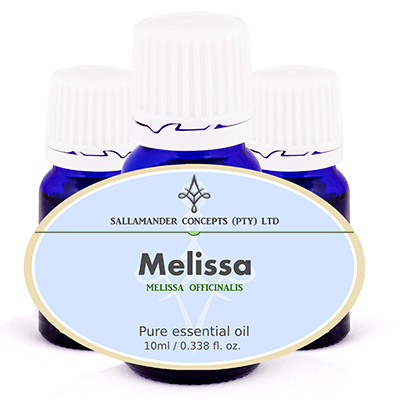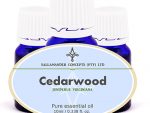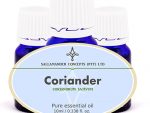Information on Melissa essential oil
Melissa essential oil is extracted from Melissa officinalis of the Labiatae family and is also known as balm, lemon balm, as well as common, sweet and bee balm.
Melissa Essential Oil (aka Lemon Balm) has a couple of uses in aromatherapy and helps to bring calmness to the mind, while having a great sedating effect, calming the heartbeat and palpitations.
It furthermore is used to correct menstrual problems, while having excellent results in fighting cold sores (herpes simplex), as well as fungal infections to a lesser degree.
Oil Properties
Melissa Essential Oil has a sweet, fresh and citrus-like smell and is pale yellow in color and has a watery viscosity.
Origin
This plant from the Mediterranean region grows to about 60 cm (2 feet) and likes soil with a high iron content and has small serrated slightly hairy leaves and small white-pink flowers.
The flowers are very attractive to bees; the name ‘Melissa’ is the Greek word for honeybee and is also know as “lemon balm’ or in Hebrew ‘Bal-Smin” meaning ‘Chief of oils.’
In the 14th century it was included in tonic water made by the French Carmelite nuns and Paracelsus (1493 – 1541) called this herb ‘The Elixir of life’, while John Evelyn (1620 -1706) described it as “sovereign for the brain, strengthening the memory, and powerfully chasing away melancholy”.
Extraction
Melissa Essential Oil is extracted from the fresh flowering tops, leaves and stems by steam distillation and yields 0.01 – 0.02 %.
Chemical composition
Some of the main chemical components are Geranial, Neral, β-Caryophyllene. Cironellal, Germacrene D, Caryophyllene oxide, Geraniol
Precautions
Melissa Essential Oil can easily cause sensitization and irritation and should always be used in low dilutions. Caution should be observed when this essential oil is used on or by people with a very sensitive skin.
Although we find that the recommended re-test (expiry) date for Melissa essential oil is at around two to three years, this oil has been reported to degrade very easily (even if kept at 4° celsius). It may be a good idea to mix Melissa essential oil with another type of anti-oxidant (such as Vit E oil) before storing in an airtight glass bottle and in the refrigerator to retard degradation of this oil.
If Melissa essential oil becomes oxidised it becomes an aggressive skin irritant.
Melissa is reported to interfere with medication if taken orally, particularly diabetes medication – this leads us to suggest caution when this oil is applied to the skin. Only use on unbroken and healthy skin at dilution rates higher than 0.5%.
Therapeutic properties
The therapeutic properties of Melissa Essential Oil are antidepressant, antispasmodic, bactericidal, carminative, cordial, diaphoretic, emmenagogue, febrifuge, hypotensive, nervine, sedative, stomachic, sudorific and tonic.
Uses
Melissa Essential Oil calms the nerves and has excellent qualities in fighting depression.
Its sedative effect is well documented.
It helps in cases of hysteria and panic and helps to slows the heartbeat, eases high blood pressure and is a tonic to the heart while regulating the menstrual cycle, also helping with period pains.
It can settle the digestive system, helps with nausea, flatulence, vomiting, dyspepsia and dysentery and has a cooling effect on fevers.
It can help with headaches and migraines associated with colds.
When treatment is started in the early stages, it can also be used as a topical treatment for cold sores (herpes simplex).
Burners and vaporizers
In vapor therapy, melissa essential oil can assist with fighting depression as well as having a greatly calming effect on the mind, reducing fevers, easing headaches, and for combating nausea.
Blended Massage Oil or in the Bath
As a blended massage oil or used in the bath, melissa oil can help with fever, headaches, depression, feeling jittery and stressed-out, settle upset stomachs and fighting fungal infections.
Blended in a Cream
Although the high aldehyde content of melissa oil may cause an allergic reaction in some individuals, it is useful to fight fungal infections, checking the blood flow in wounds and in some quarters it is also used to counteract baldness and hair loss.
Suggested Dilution Rates for Lime essential oil (Distilled)
On the skin
Adult:
Face: 0.25% to 0.9%
Body: 0.25% to 0.9%
Bath: 0.25% to 0.9%
3 to 24 months:
Do not use this oil topically. Avoid.
2 to 6 years:
Face: Avoid
Body: 0.25% to 0.5%
Bath: 0.25% to 0.5 %
6 to 15 years
Face: 0.25% to 0.9%
Body: 0.25% to 0.9%
Bath: 0.25% to 0.9%
Pregnancy
Face: 0.25% to 0.6%
Body: 0.25% to 0.6%
Bath: 0.25% to 0.6%
- When in doubt consult your doctor / medical professional before use.
- Most professionals and/or Aromatherapists will always err on the side of safety when giving advice regarding the use of essential oils and oleo resins during pregnancy.
- Quite a number of Aromatherapists advise that you should avoid all essential oils completely while pregnant, specifically during the first trimester. This is a very safe approach but may not be necessary at all.
Diffusers and Vaporisers
4 to 8 drops
General:
- When using for the first time – Always use the lowest dilution rate and build up slowly to the maximum. Stop using all essential oils on the skin if irritation or allergy occurs.
- Any advice or instruction received from a medical professional ALWAYS supersedes recommendations or advice found on this website. When in doubt consult your doctor / medical professional.
Summary
Melissa oil’s great benefit lies in its ability to calm and soothe the nerves, the digestive system, the heart, painful menstrual cycles and fevers. Caution should be observed when this essential oil is used on sensitive skin, and a low dilution rate should be used. This oil should not be used topically on children of two years and younger.
Blends
Although essential oils blend well with one another, Melissa oil blends particularly well with Basil, Chamomile (Roman), Rose, Geranium, Frankincense, Lavender and Ylang-ylang.





